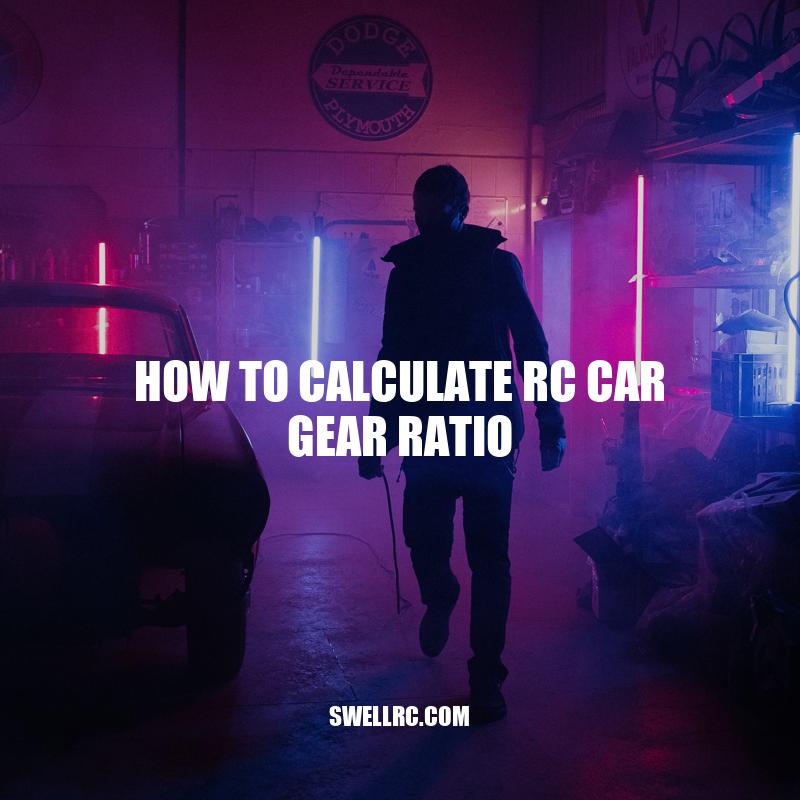How to Calculate RC Car Gear Ratio: A Beginner’s Guide.
RC cars are a popular hobby and pastime for enthusiasts of all ages. Whether battling friends in backyards or touring tracks, the speed and agility of these miniature cars can be a thrilling experience. However, not all RC cars are created equal. As with any motorized vehicle, there are numerous factors that can affect their performance. One of the most important of these is the gear ratio. The gearing on an RC car determines the speed and torque provided by the motor, and getting it right is essential to achieving peak performance. Knowing how to calculate your gear ratio is crucial to optimizing your RC car’s performance on any terrain or track. This skill can help you balance your speed and torque, giving you a smoother ride, faster times, and an edge over your competitors. In this article, we will take you through the basics of calculating gear ratios for RC cars. Whether you are a seasoned enthusiast or just starting, this guide will provide you with the knowledge needed to personalize your gear set up, take advantage of different terrains, and reach maximum performance.
Pinion Gear and Spur Gear
Calculating gear ratio involves understanding the relationship between the pinion gear and the spur gear, each with its own job to perform. Here are some key facts to keep in mind:
- The pinion gear is the small metal toothed wheel that’s directly attached to the motor.
- The spur gear is the perpendicular larger gear that meshes with the pinion gear to control the speed and torque.
- The gear ratio is determined by the number of teeth on each gear.
- Increasing or decreasing the number of teeth on each gear in proportion changes the gear ratio and will affect the performance of the car.
If you’re new to RC car racing, you might want to experiment with different gears to get the best results. But before you get started, it’s important to understand the basics of how to calculate gear ratios for RC cars. There are several websites and resources dedicated to teaching you how to do it, including gear ratio calculators, online forums, and instructional videos. Some of the more popular tools that you can use include:
- RC Cars R Us Gearing Calculator
- Petit RC Gear Ratio Calculator
- Tower Hobbies RC Gear Chart
By using these resources, you should be able to easily determine your RC car’s gear ratio and make any necessary modifications to improve the car’s performance.
How Gear Ratio Can be Calculated?
Calculating gear ratio is an important task in mechanical engineering. Here are the steps to follow:
- Count the number of teeth on both gears.
- Divide the number of teeth on the driven gear by the number of teeth on the driving gear.
- Simplify the resulting ratio by dividing the ratio by the greatest common factor.
There are various online gear ratio calculators available that can make this process easier. One such calculator is available on the csgnetwork.com website.
If you are looking for more information about gear ratios and their significance in different mechanical systems, a great resource to check out is geartechnology.com.
Calculating Gear Ratio
Calculating gear ratio for an RC car requires a bit of basic math. Here are the steps to follow:
- Count the number of teeth on both the pinion gear and spur gear.
- Divide the total number of teeth on the spur gear by the total number of teeth on the pinion gear.
- The result is the gear ratio.
For example, if the spur gear has 60 teeth and the pinion gear has 20 teeth, the gear ratio is 3:1 (60/20 = 3).
In addition to the gear ratio calculation formula, there are a few other things to keep in mind:
- RC cars that are geared for high speed will have a smaller pinion gear and a larger spur gear.
- RC cars that are geared for more torque will have a larger pinion gear and a smaller spur gear.
- Differentials, which distribute power to the wheels, can also impact gear ratio.
To simplify gear ratio calculation, you can also refer to gear ratio charts that are available from many RC car manufacturers, including Traxxas and HPI. These charts provide detailed information about the right gear ratios for different RC car models.
Here’s an example of a gear ratio chart:
| Vehicle Model | Pinion Gear | Spur Gear | Gear Ratio |
|---|---|---|---|
| Traxxas Slash 4×4 | 23 | 86 | 3.74:1 |
| HPI Trophy Truggy | 13 | 47 | 3.62:1 |
| Team Associated RC10B6 | 31 | 76 | 2.45:1 |
With a bit of research and practice, calculating gear ratios for RC cars can be a fun and rewarding experience. As you learn more about gear ratios, you’ll begin to appreciate the many factors that go into optimizing an RC car’s performance.
What is the transmission gear ratio of a RC car?
The transmission gear ratio of a RC car refers to the ratio of the number of teeth on the pinion gear (connected to the motor) compared to the number of teeth on the spur gear (connected to the wheels). This ratio determines the speed and torque of the car. For example, a lower gear ratio means higher top speed but less torque, while a higher gear ratio means lower top speed but more torque. It is important to choose the right gear ratio based on your RC car and the type of racing or driving you plan to do.
There are various websites and products that offer information and tools to help you choose the right gear ratio for your RC car, such as RC Universe and RC Gear Ratio Calculator.
Adjusting Gear Ratio
RC car enthusiasts can adjust their car’s gear ratio to suit different terrains, track layouts, or racing styles. Here are some ways to adjust gear ratios:
- Change the size of the pinion and spur gears.
- Adjust the tire size by changing the diameter or thickness.
- Modify the motor to increase or decrease its power output.
- Change the differential oil weight to change the power distribution to the wheels.
However, it’s important to note that adjusting gear ratio can impact the car’s overall performance. Increasing the gear ratio will make the car faster but sacrifice torque, while decreasing the gear ratio will make the car slower and provide more torque.
One way to determine the right gear ratio for an RC car is to experiment with different setups and test them on the track. Alternatively, you can refer to online resources such as gear ratio charts and YouTube videos where RC car enthusiasts share their experience and insights on the best gear ratios for a specific car model or racing style.
While some RC car manufacturers offer gear ratio charts and calculators on their websites, there are many independent online tools available that provide accurate gear ratio calculations. Examples include rcscoringpro.com, gearratiocalculator.net, and gearrc.com. These calculators only require inputting the number of teeth on the pinion and spur gears to generate the gear ratio, saving time and avoiding errors.
What is Gear Ratio in RC Car Gears?
Gear ratio is the relationship between the number of teeth on two gears that are meshed or engaged with each other. In an RC car, the gear ratio determines the speed and torque of the vehicle. A higher gear ratio will provide better acceleration but lower top speed, while a lower gear ratio will provide higher top speed but lower acceleration.
It is important to choose the right gear ratio for your RC car to achieve the desired performance. Some popular online RC hobby stores like Tower Hobbies and AMain Hobbies offer a wide range of gears and gear ratios for RC cars.
In addition, there are various tutorials and guides available online to help you understand and calculate gear ratios for your RC car. Some helpful resources include the RC Car Action magazine and the RC Universe forum.
Using Gear Ratio Calculators
Gear ratio calculators are useful tools that simplify the process of calculating gear ratios for RC cars. They are available in different formats, including mobile apps and online calculators. Here are some benefits of using gear ratio calculators:
- They save time and eliminate errors associated with manual gear ratio calculation.
- They can be used by both novice and experienced RC car enthusiasts.
- They provide accurate gear ratio calculations to optimize car performance.
- Some gear ratio calculators also suggest ideal gear ratios based on the car model and use case.
To use a gear ratio calculator online, you need to input the number of teeth on the pinion gear and the spur gear. Once the values are entered, the calculator will generate the gear ratio result. RC car enthusiasts can use this result to adjust the gear ratio to suit their track or terrain. Some popular gear ratio calculators include:
- RCScoringPro Gear Ratio Calculator: A free online calculator that generates gear ratio results and suggests ideal pinion and spur gear sizes based on the input.
- MyRCBox Gear Ratio Calculator: An online calculator that uses the spur gear and pinion gear sizes on the car to determine the gear ratio and RPM of the motor and wheels.
- Robinson Racing Gear Ratio Chart: A gear ratio chart that provides gear ratio values for different pinion gear and spur gear tooth configurations.
Overall, gear ratio calculators are important tools for calculating ratios accurately and delivering optimal car performance.
How do you calculate ideal gear ratio?
To calculate the ideal gear ratio, you will need the following information:
- The desired output speed in revolutions per minute (RPM)
- The input speed of the motor in RPM
Once you have this information, the formula to calculate the gear ratio is as follows:
Gear ratio = Output speed (RPM) / Input speed (RPM)
For example, if the desired output speed is 600 RPM and the motor’s input speed is 1200 RPM, the gear ratio would be:
Gear ratio = 600/1200 = 0.5
There are also online gear ratio calculators available, such as the one provided by Omni Gear, that can make this calculation easier.
Conclusion
Calculating the gear ratio is an essential skill for RC car enthusiasts seeking optimal performance from their cars. As discussed in this article, RC car gear ratio calculation is a relatively simple process involving the number of teeth on the pinion and spur gears. Adjusting the gear ratio can impact speed and torque, and gear ratio calculators are valuable tools for simplifying this process. By utilizing these valuable tools, enthusiasts can be precise and accurate when it comes to gear ratio selection.
In conclusion, the importance of gear ratio cannot be overstated. It’s a vital factor that determines the balance between speed and torque, which impacts an RC car’s overall performance. Proper gear ratio calculation and selection can enhance car performance and give an edge of competitors on the track. Therefore, understanding the fundamentals of gear ratio calculation, adjusting as necessary, and using gear ratio calculators can make a significant difference in RC car performance. With this knowledge, RC car enthusiasts can identify the right gear ratio that meets their specific setup and preferences, and ultimately have a more enjoyable and fulfilling experience with their RC car.



